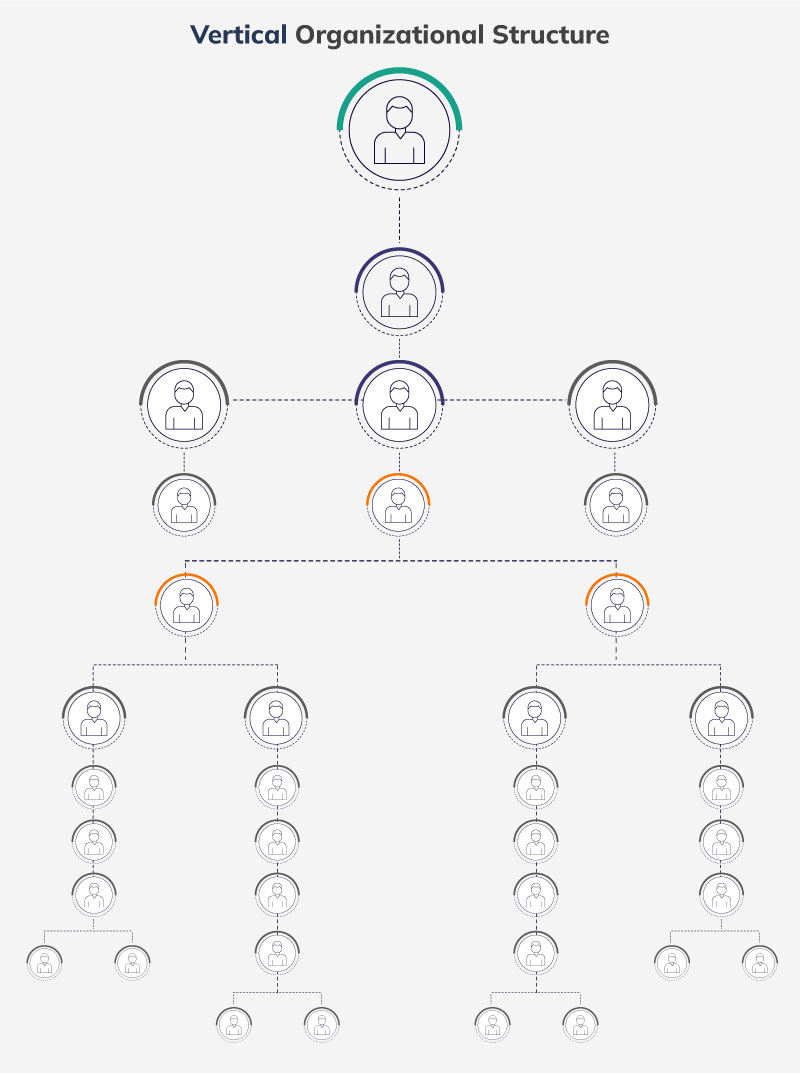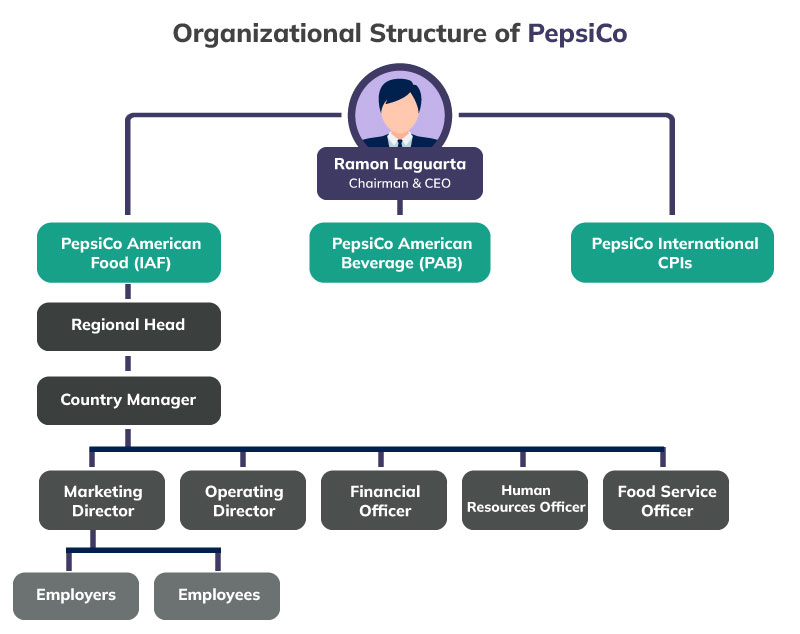What is Vertical Organizational Structure
The vertical organizational structure is similar to the hierarchical organizational structure that looks like the pyramid and the operations are managed from top to down. The vertical organizational structure has clearly defined roles and responsibilities of the employees in the organization with the highest level of leadership at the top followed by middle management and employees. Can you guess the decision-making under this organizational structure? Yes, all the decisions in the vertical organizational structure are taken by the business owner or CEO and are then communicated to the middle management who are then responsible to direct the employees according to the directives of the CEO to ensure the achievement of the business goals. Thus, in the vertical organizational structure, each individual is supervised by the manager or departmental head working above them. The chain of command in the vertical organizational structure is clear with all the communication taking place from top to bottom.
Table of Contents

The centralized management processes in the vertical organizational structure exhibit that the high-level managers in the organization are held responsible for taking all the business decisions and limited authority is provided to the employees. The vertical organizational structure is suitable for large business organizations as the vertical organizational structure involves the presence of a large number of managerial heads.
Advantages of Vertical Organizational Structure
The vertical organizational structure includes top to down management processes where the managers are held responsible to command and control the operations of the employees. The vertical organizational structure has several advantages which are discussed as follows-
Clarity in roles- One of the key advantages of vertical organizational structure is clarity in roles and responsibilities of the employees as vertical organizational structure includes centralized decision making where each individual is supervised by the reporting head. The chain of command under this organizational structure also helps to ensure efficiency in organizational operations through clarity in the roles of employees.
Performance- The vertical organizational structure helps to drive higher performance of employees as compared to the horizontal organizational structure as all the actions of the employees are monitored and supervised by the managers working above them and the clear lines of communication also help in maintaining coordination between the managers.
Economies of scale- Employees in the vertical organizational structure are organized under different job categories which allow employees undertaking similar tasks to share various resources which help to achieve economies of scale. Also, the employees are engaged in repeated tasks under this structure which helps in promoting employee specialization and economies of scale.
Disadvantages of Vertical Organizational Structure
Despite the importance of vertical organizational structure for work clarity, there are various disadvantages associated with the vertical organizational structure. The disadvantages of the vertical organizational structure are discussed as follows-
Lack of creativity- If all the decisions are taken by the entrepreneur on the top then it leads to a decline in employee engagement in various innovations and change management processes and also results in a decline in employee creativity in the organization. All the ideas are transmitted down the chain of command under the vertical organization structure due to centralized decision making which also discourages the employees from sharing their ideas.
Role ambiguity- Due to lack of engagement of the employees in the decision-making, the chance of flexibility in the organization declines and it leads to dictatorship and bureaucracy in the organization which can result in a decline in employee motivation and job satisfaction.
Siloed thinking and isolation- Vertical organization structure also results in siloed thinking among the employees as each employee is held responsible to work in isolation from the others in the specific department according to the task assigned by the supervisor. This can cause problems in collaboration in the organization with a decline in interdepartmental communication.
Example of Vertical Organizational Structure
Despite the disadvantages of the vertical organizational structure, most organizations adopt the vertical organizational structure, PepsiCo is one such example. The organizational structure of PepsiCo is incredibly vertical with a clear chain of command and hierarchical operations. Ramon Laguarta is the CEO of PepsiCo who yields tremendous power in the company and exercises control from top to bottom. The operations of PepsiCo are managed and organized in different divisions and departments with each division being headed by the president, CEO, or EVP. The organizational structure of PepsiCo is represented as follows-

The above illustration of the organizational structure of PepsiCo represents that all the operations of PepsiCo are headed by managerial heads who are then responsible to manage the operations of the organization. The operations of PepsiCo are organized in three major operating units which include PepsiCo Americas Foods (PAF), PepsiCo Americas Beverages (PAB), and PepsiCo International (PI). Each division of the organization is managed and headed by the president and then the regional heads are responsible to answer to the president. Besides this, the chain of command of PepsiCo goes from CEO to regional heads, country managers, and functional heads.
The vertical organizational structure with a clear chain of command and hierarchical decision-making helps PepsiCo to effectively manage the global operations. It helps to facilitate clear monitoring and control of all the operations in the organization from top to bottom. Besides this, the vertical organizational structure at PepsiCo is also advantageous from the point of effective implementation of all the policies, decisions, and strategies. The vertical organizational structure of PepsiCo with regional heads at each division also helps in focusing on the customer needs in the regional markets.
FAQs
How does a Vertical Organizational Structure differ from a Flat Organizational Structure?
A Vertical Organizational Structure has multiple hierarchical levels, whereas a Flat Organizational Structure has fewer levels and emphasizes decentralization and employee empowerment.
Can organizations combine elements of both Vertical and Flat Organizational Structures?
Yes, organizations can adopt hybrid structures that combine elements of both to leverage the advantages of each while mitigating their respective limitations. But, in these cases make sure the roles and responsibilities are effectively communicated as it can become confusing.
Previous Structure
Horizontal organizational structureNext Structure
Matrix organizational structure
 Proof Reading
Proof Reading  Copy Writing
Copy Writing  Resume Writing
Resume Writing  Blogs
Blogs Guides
Guides SOP's
SOP's Student Resources
Student Resources Research Topics
Research Topics Login
Login Register
Register